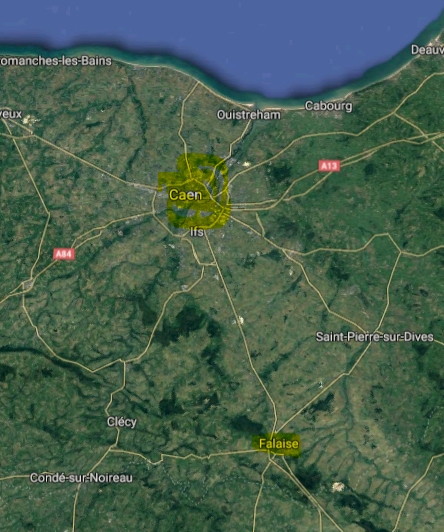Battle of Caen
The city of Caen is one of the major objectives of the British armies engaged in Normandy. On the evening of June 6 the conquest of this city, according too the original plans, was to fall into the hands of the Allies on D-Day, but this did not happen.
At D-Day + 1 (June 7), General Montgomery, commander of the Allied land forces in Normandy, launched Operation Perch, which aimed to relaunch the offensive of the previous day in order to finally seize Caen, but the Germans defended themselves relentlessly and prevented the British from advancing.
The first assaults were stopped by the German soldiers and tanks of the 12th Panzer Division defending Caen and especially the attack carried out by the 185th brigade of the 3rd British infantry division in the village of Lebisey, bordering the capital. The commander of the Panzer Division, Edgar Feuchtinger, had 16,000 men, 146 tanks, 4 battalions of motorised infantry, about 50 guns and a battalion of Flak guns with 24, 88-calibre guns buried north of Caen..
Invasion Defences for the Isle of Purbeck
The critical months of the possible German invasion were between June 1940 and September 1940, but preparations had already been started by V Corps in early 1940. The 50th division headquarters was at Blandford Camp, with three infantry brigades in close proximity of the Dorset coast. Their greatest fear was a tank invasion, to mitigate and slow the invasion force down, allowing reinforcements to arrive, they resorted to creating tank traps. These consisted of tens of miles of anti-tank ditches being dug.
They were typically 18 feet (5.5 m) wide and 11 feet (3.4 m) deep and could be either trapezoidal or triangular in section with the defended side being especially steep. Consequently, these defences, known as Stop lines, generally supplemented pre-existing barriers to tanks, such as rivers and canals; railway embankments and cuttings; thick woods; and other natural obstacles. Using this format it was possible to make an anti-tank island by surrounding a protected facility, for example the Blandford Garrison was surrounded by tank obstacles.
The largest Island was the Isle of Purbeck, where its Stop line ran from Weymouth to Dorchester another from Dorchester to Wareham, thereby sealing off the Isle of Purbeck from the rest of Dorset. The aim was to keep any invading German forces bottled up on the Isle of Purbeck until reinforcements arrived to drive them back into the sea. Consequently, the Isle Purbeck inhabitants would have been subjected to friendly fire. It’s interesting to note that the population of the Isle of Purbeck was considered dispensable, unlike the population of Dorchester, Maiden Newton, Yeovil, Bournemouth, Poole, Wimborne Minster and Wareham who were all situated on an their own anti-tank island. 1
